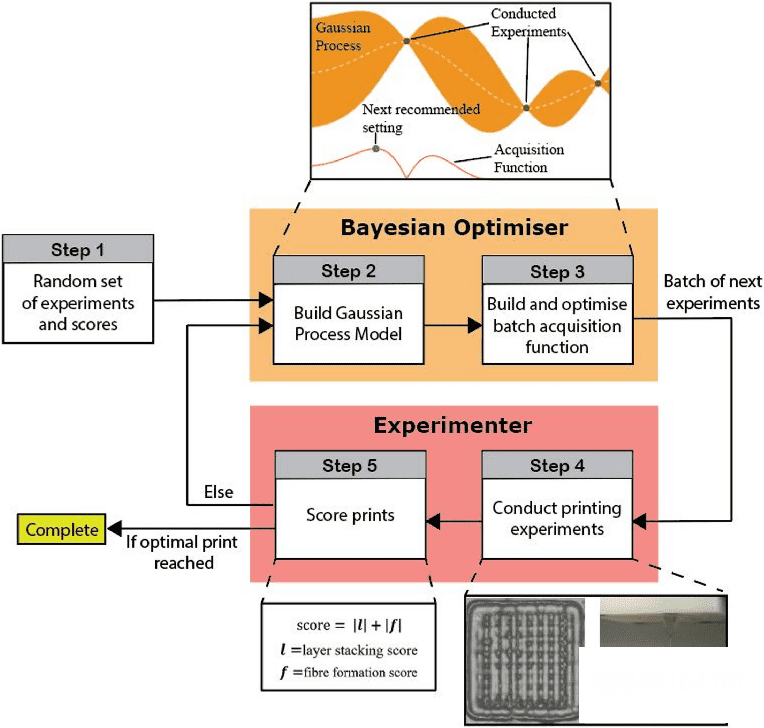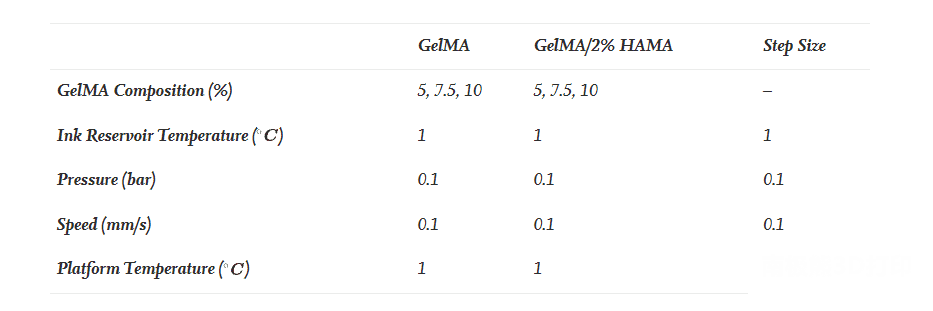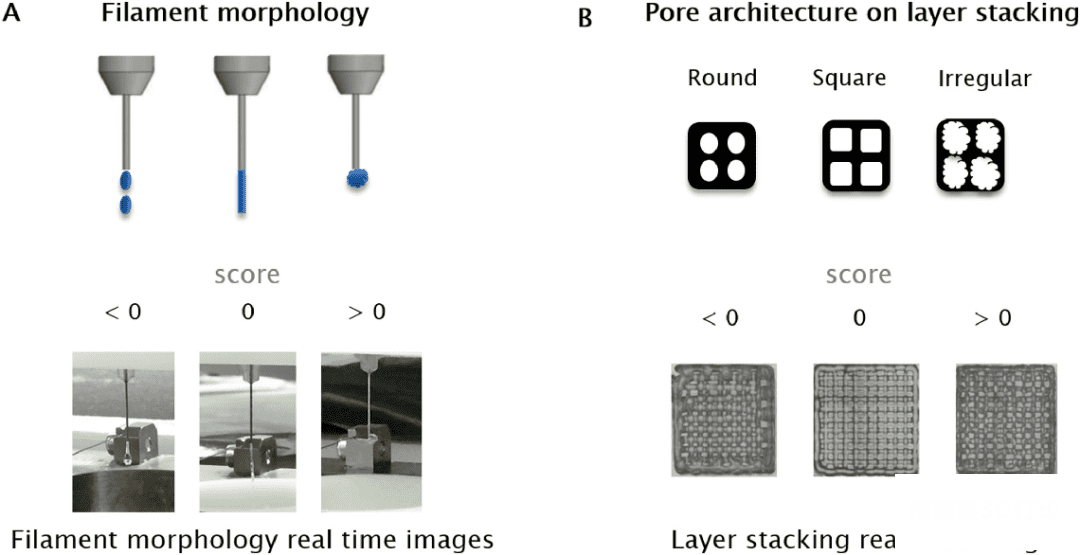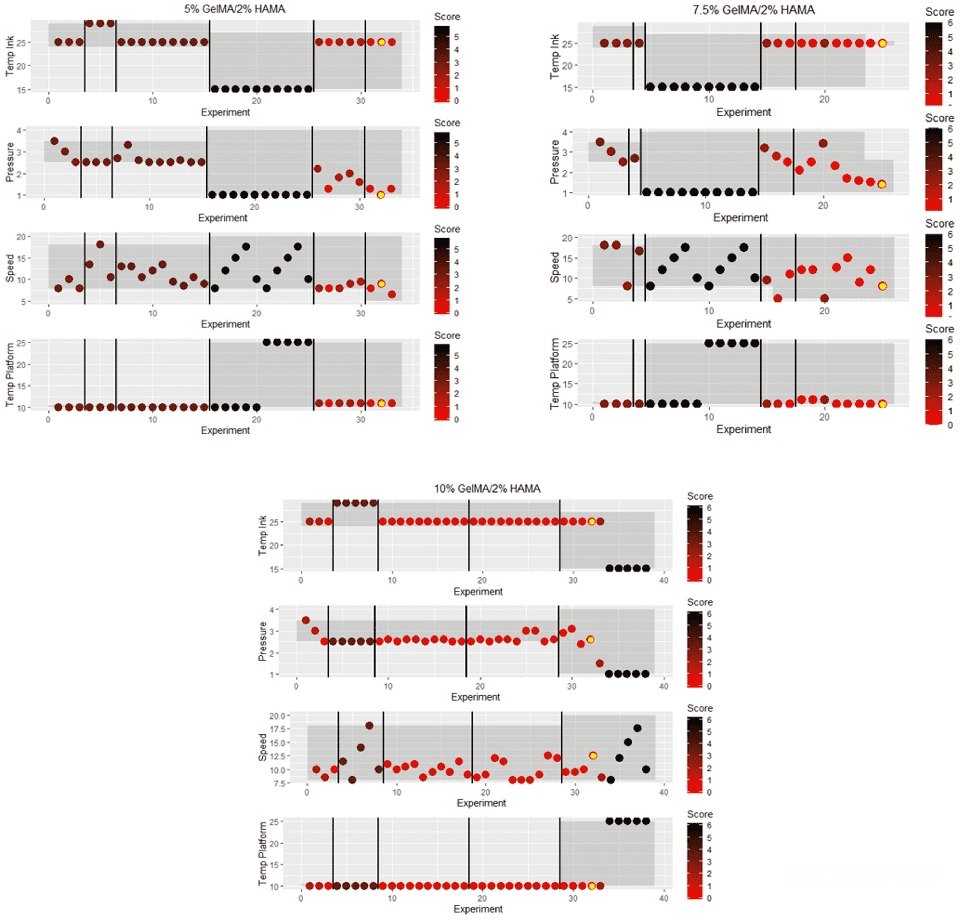Many factors related to bioink properties, printing parameters, and post-print curing play an important role in the optimization of the printing process. Although a lot of research has been done on qualitative assessment of printability, there are few studies on quantitative methods for assessing printability. Published in the journal Applied Materials Today titled “Coupling machine learning with 3D bioprinting to fast track optimisation of extrusion printing”, a team from the University of Wollongong and Deakin University in Australia explores machine learning as a novel tool to Quantitatively assess printability and fast-track methods for optimizing extrusion printing for reproducible 3D scaffold construction.
Background introduction
Bioinks are an essential component of the bioprinting process, serving as a delivery medium for cells and growth factors, and as a support material for cell adhesion, proliferation, and thriving after printing. While maintaining cytocompatibility, an ideal bioink should possess two key physical properties: “printability” to form complete 3D structures, and “mechanical stability” for good shape fidelity of printed structures . Therefore, 3D-printed bioinks should preferably adopt fluid properties with reasonable printability during their extrusion process. Numerous factors related to physicochemical properties, printing parameters, and post-print curing play an important role in optimizing the printability of any bioink (Figure 1). The rheology of bioinks mainly depends on their viscoelasticity and shear behavior, which in turn strongly depends on the concentration formulation of the ink. In addition, the extrudability and extrusion uniformity of the bioink also contribute to the printability. In addition to the physical properties of the bioink, the temperature of the 3D printer, nozzle diameter, nozzle type, printhead speed, and platform temperature can all improve printability.
Fine-tuning so many variables to complete a reproducible 3D scaffold is a tedious and time-consuming process that researchers currently rely on mostly trial and error. Therefore, there is an increasing need for a rapid method to evaluate and optimize the printability of bioinks. Modern machine-learning approaches provide insight into this problem, which can model black-box functions with minimal experimental data, and are increasingly used for the efficient design of new materials and processes.
This study proposes a Bayesian optimization (BO)-based machine learning approach to achieve the goal of finding optimal parameters with minimal experimentation. This coupled Bayesian optimization can accelerate the printability optimization of bioinks for extrusion printing. A range of concentrations of methacryloyl gelatin (GelMA) and GelMA/methacryloyl hyaluronic acid (HAMA) were selected as optimized examples in this paper.

Materials and methods
1. Materials
In terms of materials, the researchers fabricated lattice structures (10 × 10 × 2.5 mm) with 500 μm wide strands and 130 μm splices by extrusion printing using an EnvisionTEC 3D Bioplotter (GmbH Germany). The bioink ratios used in the study were: 10% (w/v) GelMA, 7.5% (w/v) GelMA, and 5% (w/v) GelMA; 10:2% (w/v) GelMA/HAMA , 7.5:2 % (w/v) GelMA/HAMA and 5:2 % (w/v) GelMA/HAMA, covering a broad viscosity range from low, medium to high. After each layer was deposited, 20 s of UV irradiation was used to crosslink the bioink.
2. Algorithms
In terms of algorithms, the researchers constructed a Bayesian optimizer-based “black box system” framework to study the effects of a series of parameters such as bioink storage temperature, pressure, print head speed and platform temperature on printability. The results of the experiments are fed back to the experimenter, who then runs printer tests with recommended settings and scores performance, and these results are fed back into the optimizer, which iterates over and over until the best printing result is achieved.

The framework first provides the Bayesian optimizer with a random set of variable bioink mix ratios and printer settings (bioink storage temperature, pressure, printhead speed, and platform temperature), as well as filament formation and layer stacking performance-based Relevant print scores. The system is a black-box system containing many complex relationships between input variables and output print scores. To overcome this problem and achieve the search goal, researchers use past experimental data based on a Bayesian optimizer to construct probability estimates for black-box systems modeled by Gaussian processes. The mean and covariance of the model were used to construct an acquisition function that was optimized to recommend the next printer setting to test. This recommended printer setting is defined as the location where the Bayesian optimizer expects the highest probability of finding the best print score. Experiment proposals provided by the optimizer are provided to the experimenter in batches at each iteration to allow the experimenter to run and score multiple experiments at once.

To evaluate the printing effect, the researchers introduced a scoring system for the filament morphology during extrusion and the pore structure on the layer stack to quantitatively assess the printability. As shown in Figure 3A, the bioink state at the needle tip will exhibit three distinct changes, including the formation of i) droplets, ii) continuous filaments, or iii) irregular shapes due to excessive gelation.The uniform filament hanging from the nozzle tip was rated “0” and thus considered a good measure of the printability of GelMA and GelMA/HAMA mixtures
standard
. In addition, the researchers defined metrics to evaluate the ability to fabricate 3D structures (shape fidelity). Lattice with clear pore structure is highly correlated with the properties of extruded filaments, droplet formation during extrusion will result in 3D constructs with small round pores, while over-gelled bioinks will result in irregular shapes The pore construct is shown in Figure 3B. Therefore, the bioink in the proper gel state will form a standard lattice containing different square pores, with improved shape fidelity and a score of “0”.

Printed Filament Morphology and Pore Structure on Layer Stack During Extrusion from the Needle Tip
A) Schematic and live image of the filament morphology;
B) Schematic and live image of the pore structure on the stack of 10 × 10 mm lattice structure layers
3. Results and Discussion
The changes in the range of printing parameters including the experimental results are shown in Figures 4 and 5. The total print score was obtained by calculating the two values of the filament formation fraction and the layer stacking fraction. A total printing score of “0” demonstrates the optimal printing conditions for GelMA and GelMA/HAMA mixtures (yellow dots in Figures 4 and 5). The researchers found that the bioinks achieved ideal filament formation of 10%, 7.5% and 5% (w/v) GelMA at temperatures of 22°C, 20°C and 18°C, respectively. Whereas a slightly elevated temperature of 25°C could achieve a filament morphology score of “0” for all three GelMA/HAMA concentrations. The shaded area represents the range of each print parameter, and the black line segments represent each batch. In a space of 6000 to 10,000 possible print settings, the Bayesian optimization algorithm was able to perform at 10%, 7.5% and 5% (w/v) GelMA’s 19th, 4th and 47th experiments and 10%, 7.5% and 5% (w/v) Optimal printer settings found in experiments 32, 25 and 32 of 5% (w/v) GelMA/2% (w/v) HAMA mixed inks.

Use black vertical line segments between batches;
Circles represent scores for a given experiment (red = better print);
The shaded area is the range for a given print parameter;
Yellow dots indicate best printing

black vertical line segments between batches;
Circles represent scores for a given experiment (red = better print);
The shaded area is the range for a given print parameter;
Yellow dots indicate best printing
in conclusion
This study demonstrates the promise of coupling machine learning to optimize the printability of extrusion printing of GelMA and GelMA/HAMA bioinks for reproducible 3D printing with good shape fidelity. The findings demonstrate a novel quantitative approach to optimize extrusion printability of GelMA and GelMA/HAMA bioinks. This Bayesian optimization technique can easily be applied to the printability optimization of other types of (bio)ink systems, where extrusion-based models are employed. Furthermore, it is clear that this method can successfully accelerate the extrusion bioprinting experimental process compared to the tedious and time-consuming traditional trial-and-error optimization. This research reveals the promising application of machine learning in this rapidly developing field of 3D bioprinting.
references
Ruberu K , Senadeera M , Rana S , et al. Coupling machine learning with 3D bioprinting to fast track optimisation of extrusion printing[J]. Applied Materials Today, 2021, 22:100914.
https://doi.org/10.1016/j.apmt.2020.100914
(responsible editor: admin)


0 Comments for “Combining machine learning with 3D bioprinting to fast-track optimized extrusion printing”